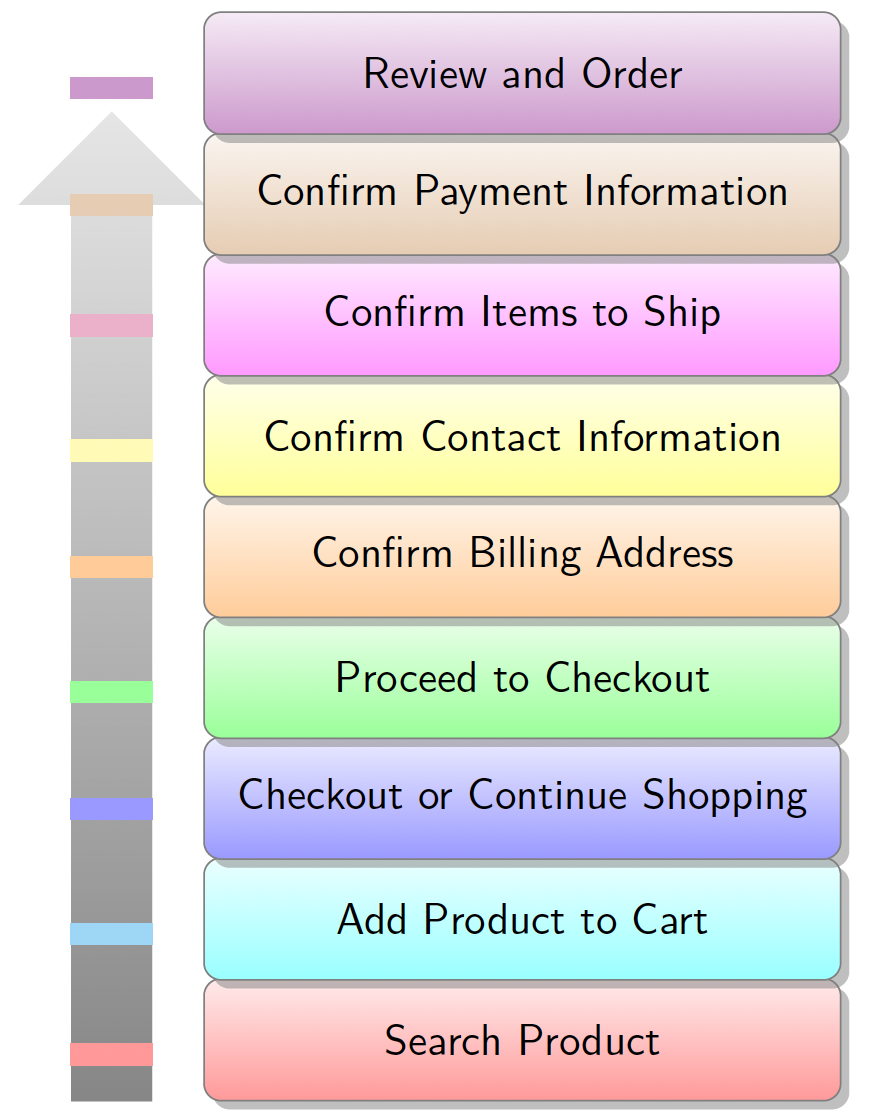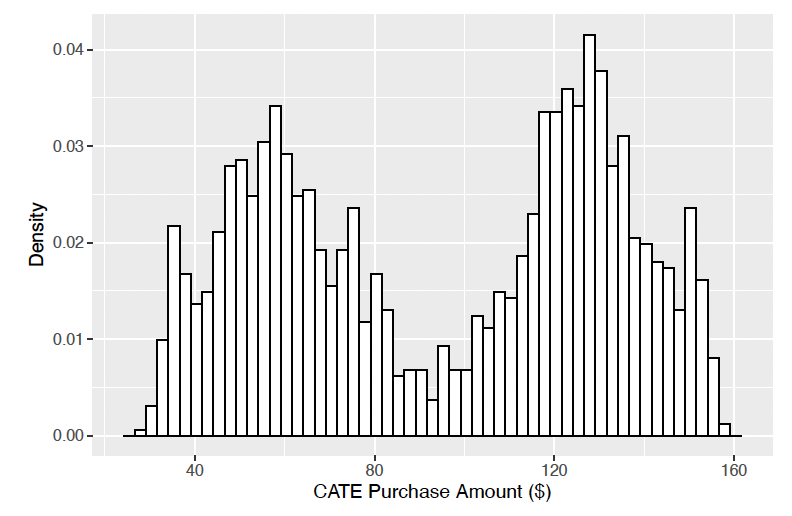What is the Value of Improving the Customer Experience in E-Commerce?
Improve customer experience and increase engagement at your online store by simplifying checkout.
By Murat Unal in Marketing Analytics Causal Inference Causal Machine Learning
February 27, 2023

The Customer Experience
Among the three stages in the customer’s journey with a business, namely, pre-purchase, purchase, and post-purchase, the purchase stage is key in shaping customer experience because it is related to several key behaviors, such as choice, ordering, and payment [1].
As such, a long and complicated checkout process, in particular, can be a major dent in converting visits into orders. In fact, it is consistently ranked among the top reasons for shopping cart abandonment. Hence, eliminating frictions at the purchase stage can significantly improve the customer experience and thereby reduce the rate of cart abandonment.
Arguably, the best example in minimizing frictions during the checkout process comes from Amazon. This is because, since 1997 Amazon has been using its 1-Click ordering technology, which allows its customers to place orders in a single step. Amazon patented the technology in the US in 1999 and prevented other retailers from adopting it in their checkouts. It has been speculated that this feature alone increased Amazon’s sales significantly and the patent was estimated to be valued at $2.4 billion annually [2].
Amazon lost its exclusive right to the one-click buying technology because its 1-Click patent expired on September 12, 2017. Since then online retailers and platforms have gained the opportunity to incorporate the feature into their stores without being forced to pay license fees.
However, even with the hurdles being removed, many businesses still debate in deciding whether to incorporate one-click buying into their online stores. A time-consuming checkout involving multiple steps, instead of a streamlined one, continues to be the norm in e-commerce [3].
Part of this is understandable because, apart from anecdotal estimates, the economic value of offering shoppers the option to order online in a single step is a secret, known only by Amazon [4].
That is, until recently. In our latest research, published in Management Science [5], we have investigated and quantified the value of transforming the online checkout from something that looked like this:

To this:

Challenge
To quantify the value of transforming the checkout process, we collaborated with an omni-channel retailer, and analyzed customer shopping data over a period of 32 months before and after launching one-click buying at the online store. The main challenge we faced was in establishing causality. That is, how can we be confident that the observed changes in customer purchases were caused by customers’ adoption of one-click buying and were not attributable to something else such as self-selection? For instance, customers who had more purchases before the launch of one-click checkout might be more likely to adopt it as they might expect to benefit more after registering for it.
One way to overcome this challenge is by running a randomized experiment, whereby customers would be randomly assigned to two groups: multi-step buying and one-click buying. This would eliminate systematic bias, and comparing the purchase behavior between two groups would allow us to establish the causal effect that we are after. However, designing and implementing a large-scale experiment over a long time period in the course of commercial operations is challenging in its own ways. For example, maintaining the integrity of the experiment and ensuring that one group of customers are excluded from other marketing initiatives becomes increasingly difficult over time.
Therefore, we tackled this problem using temporal data of same customers and applying well-established observational causal inference methods. Specifically, we designed a two-step identification strategy whereby we accounted for potential self-selection, which could threaten the credibility of our causal inference. Using this approach we first created 801 matched pairs of one-click buying adopters and non-adopters who are statistical twins in observable measures. Next, we used these matched pairs to analyze purchase differences between adopters and non-adopters. We also applied causal machine learning to understand the impact at the individual level (CATE), which enabled us to relate customer characteristics to the causal impact of adopting one-click buying.
Findings
We found one-click buying is effective in lifting customer purchases and does so by making adopting customers purchase more often with more items per order. The impact of one-click buying on customer purchases post adoption is economically significant and persistent over time. Specifically, compared to non-adopters, adopters on average, spend 28.5% more, place 43% more orders and order 36% more items per month, in the 15 months following adoption. We also found substantial variation in the impact across customers. As shown below, the magnitude of the increase in purchase amount, 15 months after adoption, ranges from $29 to $158.

Adopting one-click buying has a limited impact on high-value customers (based on past purchase patterns) but has a larger impact on customers who previously purchased less and visited the online store less often. Moreover, we found customers who adopted the feature within five months of its inception were more responsive to it than those who adopted it afterward, and the impact is larger on older people.
Mechanism
What is the reason that reducing the ordering process to a single step is causing customers to change their behavior at the online store? One might think that the increase in online purchases is due to the channel-switching behavior to online from offline or due to increase in impulse buying. However, analyzing offline purchases and product returns we found no evidence for channel substitution and impulse buying.
We argue that introducing one-click ordering provides an opportunity for the online retailer to improve customer engagement, which ultimately leads to changes in purchase behavior. The rationale for this proposition, comes from recognizing the weight that online features carry in shaping the customer experience in e-commerce.
It has been well documented in the literature that online businesses equipped with online decision aids such as sorting alternatives or filtering them based on price, brand etc., can facilitate and enable customers to attain their shopping goals. Customers exert less effort yet make better decisions when online decision aids are available. Moreover, usage of online decision aids is associated with increased satisfaction and likelihood of repeat visits to the website [6,7].
Similar to decision aids, one-click buying is an online feature that enhances customer experience by reducing the time and effort during checkout and improves the usability of an online store. This increased convenience leads to a better shopping experience online, which ultimately increases customers’ engagement with the retailer.
Richer engagement could manifest itself through customers’ tendency to make more visits to the retailer’s website and spend more time upon visit. It could also be reflected in customers’ tendency to expand their purchases across product categories. Indeed, our analysis of customer activity online and purchases across categories, confirms the main reason one-click ordering is so effective is because it provides an avenue for the online retailer to improve customer engagement, which eventually leads to the positive changes in purchase behavior.
We found that, on average, one-click adopters increase their website visits by 16% in the long term. They also view more pages (an increase of 11%) and spend more time (an increase of 22%) upon visit. We also found adopters deepen their relationship with the firm by expanding their purchases across categories (an increase of 8%) in the long term.
Takeaways
The end of Amazon’s hold on the one-click checkout technology offers opportunities to online businesses, and naturally leads to the question about the economic value of introducing this technology.
Our findings offer three important insights. First, because businesses are increasingly concerned about customer engagement, our findings illustrate the importance of investments and efforts toward improving customer experience through advanced features in e-commerce such as a seamless checkout process.
Second, we provide evidence on the heterogeneous treatment effects of one-click buying that can assist businesses in scoring and targeting customers and in allocating resources across individual customers when designing marketing activity associated with one-click buying.
Finally, we present evidence on the economic value of one-click buying for e-commerce businesses. Because an increase in purchases as well as customer activity online is expected after launching the technology, having solutions in place to effectively and efficiently manage traffic to the website and fulfill orders so that customers have a positive experience is essential.
References
[1] Lemon K.N., Verhoef PC. Understanding customer experience throughout the customer journey. (2016), Journal of Marketing 80(6):69–96.
[2] Arsenault M. How Valuable is Amazon’s Patent. (2017), Rejoiner.
[3] Edward S. The Current State of Checkout UX-18 Common Pitfalls & Best Practices. (2021), Baymard.
[4] Wagner R.P., Jeitschko T. Why Amazon’s ‘1-Click’ ordering was agame changer. (2017), Knowledge at Wharton.
[5] Unal M., Park Y-H. Fewer Clicks, More Purchases.(2023), Management Science.
[6] De P., Hu Y., Rahman M.S. Technology usage and online sales:An empirical study. (2010), Management Science. 56(11):1930–1945.
[7] Haubl G., Trifts V. Consumer decision making in online shopping environments: The effects of interactive decision aids. (2000), Marketing Sci. 19(1):4–21.
- Posted on:
- February 27, 2023
- Length:
- 7 minute read, 1459 words